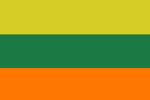Republic of Hugia
Republic of Hugia | |||||||||||
|---|---|---|---|---|---|---|---|---|---|---|---|
| 2020–2021 | |||||||||||
|
Flag | |||||||||||
| Motto: "It's Pretty Huge!" | |||||||||||
| Anthem: Hugia Will Stay Huge | |||||||||||
 Location of Hugia (Google Maps) | |||||||||||
| Capital and largest city | Hugia City 12°13′25″N 21°24′52″E / 12.22361°N 21.41444°E | ||||||||||
| Official languages | English | ||||||||||
| Recognized languages | |||||||||||
| Religion | Christianity | ||||||||||
| Demonym(s) | Hugian | ||||||||||
| Government | Unitary parliamentary republic | ||||||||||
| President | |||||||||||
• 2020 – 2021 | Henry Vireyica | ||||||||||
| Legislature | Parliament | ||||||||||
| Upper Court | |||||||||||
| Lower Court | |||||||||||
| History | |||||||||||
• Established | 2020 | ||||||||||
• Regime change | 2021 | ||||||||||
| Population | |||||||||||
• 2020 census | 357,000 | ||||||||||
| Currency | Hugian Hug | ||||||||||
| Time zone | UTC+01:00 | ||||||||||
| Driving side | right | ||||||||||
| |||||||||||
| Today part of | Chad | ||||||||||
The Republic of Hugia was a fictional landlocked micronation in Central Africa. It was founded by the former president, Henry Vireyica. The republic lasted for 10 months until the kingdom succeeded it through a regime change. It's predecessor was also the infamous First Hugian Party, a fictional political party.
History
Geography
Hugia was a landlocked country located in Central Africa. Its approximate area is 29,500 square kilometers and would've been the 116th largest country in the world. Slightly bigger than Panama and slightly smaller than Czechia. Claiming the entire province of Sila from the Republic of Chad, they bordered Chad to the north and west, Sudan to the east, and Central African Republic to the south. Many towns were scattered throughout the whole micronation, with its Hugia City being in the center. Hugia is in one ecoregion: Sahel.
The country was mainly hot and dry because of the region it was located in. Hugia was located in the Sahelian region, which is a dry, hot, and arid region in Africa.
Religion
Christianity was the country's main religion, specifically Protestant Christianity. This was Africa's northernmost Christian micronation. This was controversial, as many people who lived in this region were Muslim and not Christian. There were no plans to make Islam an official religion, but a recognized majority religion.
